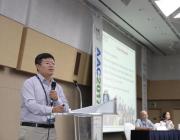摘要:
Long-term measurements of particle number size distributions in combination with thermodenuder analysis have been performed since July 2003 at the Central European station of Melpitz, Germany. Up to the end of 2011, 20% of all investigated days during the 8.5 years of measurements showed new particle formation and subsequent growth. To investigate the role of various chemical compound candidates for condensational nanoparticle growth, we focused on nucleation events in which the measured size distributions with and without thermodesorption both showed growth patterns (accounting for up to similar to 85% of all nucleation events). In this study, particulate compounds that volatilize at 300 degrees C were specifically defined as "volatile," in contrast to "nonvolatile" compounds, which remain in the particulate phase after being heated to 300 degrees C. A strong correlation between ambient temperature and growth rate associated with volatile substances (except gaseous sulfuric acid) was found, which implies the importance of organics (possibly oxidized biogenic organic compounds) in particle growth at Melpitz. The contributions of the volatile compounds to the growth rate due to condensation of gaseous sulfuric acid and organics were found to be about 19% and 47%, respectively. The remaining similar to 25% was attributed to nonvolatile residuals, which appear to form gradually during the particle growth process and are characterized as extremely low-volatility compounds. The growth rate associated with volatile components exhibited significant seasonal variation, with the highest value during summertime, whereas the growth rate associated with the nonvolatile fraction showed less fluctuation.附注:
ISI Document Delivery No.: EK4DRTimes Cited: 4Cited Reference Count: 79Wang, Zhibin Birmili, Wolfram Hamed, Amar Wehner, Birgit Spindler, Gerald Pei, Xiangyu Wu, Zhijun Cheng, Yafang Su, Hang Wiedensohler, AlfredSu, Hang/A-6226-2010; Wehner, Birgit/C-2650-2014; Cheng, Yafang/F-9362-2010; Wu, Zhijun/A-7041-2012; Wang, Zhibin/K-7365-2013Su, Hang/0000-0003-4889-1669; Cheng, Yafang/0000-0003-4912-9879; Pei, Xiangyu/0000-0003-1150-3001German Federal Environment Ministry (BMU) [FE 370343200]; ACTRIS (Aerosols, Clouds, and Trace gases Research InfraStructure Network); European project - EU; Federal Environment Agency; Saxon State Office for Environment, Agriculture and Geology of GermanyThis study was supported by the German Federal Environment Ministry (BMU) grant F&E 370343200 (German title: "Erfassung der Zahl feiner und ultrafeiner Partikel in der Aussenluft"), 2008-2010. The Melpitz measurements have been supported by ACTRIS (Aerosols, Clouds, and Trace gases Research InfraStructure Network), a European project funded by the EU FP7 that integrates atmospheric research activities at various European observation sites, and by national projects of the Federal Environment Agency and the Saxon State Office for Environment, Agriculture and Geology of Germany. We gratefully acknowledge Thomas Tuch and Achim Gruner for instrumental and technical support at Melpitz and Andrea Haudek for construction of the thermodenuder. The data archive is managed by the Leibniz Institute for Tropospheric Research and is available upon request from the corresponding author.4225Amer geophysical unionWashington2169-8996